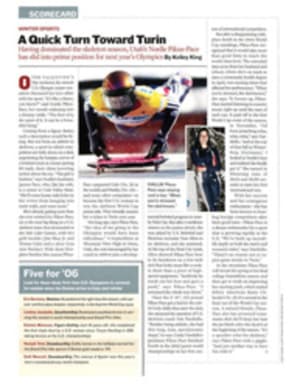
A Quick Turn Toward Turin
Over valentine's Day weekend, the newest U.S. Olympic winter sensation discussed her love affair with her sport. "It's like a dance, you know?" said Noelle Pikus-Pace, her mouth widening into a dreamy smile. "The flow of it, the quiet of it. It can be a beautiful thing."
Coming from a figure skater, such a description would be fitting. But not from an athlete in skeleton, a sport in which competitors are belly-down on a sled, negotiating the hairpin curves of a bobsled track at a bone-jarring 80 mph, their chins hovering inches above the ice. "The girl is fearless," says Noelle's husband, Janson Pace, who, like his wife, is a senior at Utah Valley State. "She'll come home with holes in her wrists from banging into track walls, and want more."
She's already getting more than she ever wished for. Pikus-Pace, 22, is the next big thing on a U.S. skeleton team that dominated at the Salt Lake Games, with two gold medals (Jim Shea Jr. and Tristan Gale) and a silver (Lea Ann Parsley). With three first-place finishes this season Pikus-Pace surpassed Gale (No. 25 in the world) and Parsley (No. 10)--and every other competitor--to become the first U.S. woman to win the skeleton World Cup points title. That virtually assures her a ticket to Turin next year.
Not long ago, says Pikus-Pace, "the idea of me going to the Olympics would have been ridiculous." A heptathlete at Mountain View High in Orem, Utah, she was encouraged by her coach in 1999 to join a developmental bobsled program in nearby Park City. But after a mediocre season on the junior circuit, she was asked by U.S. Bobsled and Skeleton recruiter Tom Allen to try skeleton, and she assented. At the top of the Park City track, Allen showed Pikus-Pace how to lie facedown on a low-tech sled that looks more like a cookie sheet than a piece of high-speed equipment. "Suddenly he stuck out his foot and gave a push," says Pikus-Pace. "I screamed the whole way down."
Once the 5'10", 155-pound Pikus-Pace got a feel for the subtle body shifts that steer the sled, she attracted the attention of U.S. skeleton coach Tim Nardiello. "Besides being athletic, she had this long, lean, aerodynamic shape," he says. Under Nardiello's guidance Pikus-Pace finished fourth in the 2002 junior world championships in her first season of international competition.
But after a disappointing 14th-place finish in the 2004 World Cup standings, Pikus-Pace recognized that it would take more than good form to reach the world-class level. The extended time away from her husband and school, where she's on track to earn a community health degree in April, was causing stress that affected her performance. "When you're stressed, the sled knows," she says. To loosen up, Pikus-Pace started listening to country music right up until the start of each run. It paid off in the first World Cup event of the season, in November. "I'd been preaching relax, relax, relax," says Nardiello, "and at the top of that hill in Winterberg [Germany] I looked at Noelle's face and realized she finally got it." She turned in blistering runs of 59.03 and 59.80 seconds to earn her first international win.
With her success and her contagious enthusiasm--she has been known to bear-hug foreign competitors after their good runs--Pikus-Pace is a dream ambassador for a sport that is growing rapidly in the U.S. "We've built up incredible depth on both the men's and women's sides," says Nardiello. "There's no reason not to expect great results in Turin."
In the meantime Pikus-Pace will devote the spring to her final college heptathlon season and then get to work on improving her starting push, which trailed fellow American Katie Uhlander's by .25 of a second in the final run of the World Cup season. A natural blonde, Pikus-Pace also has promised teammates that she'll keep her hair the jet-black color she dyed it at the beginning of the season. "It's a speedier color for skeleton," says Pikus-Pace with a giggle. "And just another way to have fun with it." ■
Five for '06
Look for these likely first-time U.S. Olympians to contend for medals when the Games arrive in Italy next winter
Eric Bernotas, Skeleton
He peaked at the right time this season, with second- and first-place finishes, respectively, in the final two World Cup races.
Lindsey Jacobellis, Snowboarding
Dominated snowboardcross in winning the women's world championship and Grand Prix titles.
Kimmie Meissner, Figure skating
Just 15 years old, she completed the first triple Axel by a U.S. woman since Tonya Harding in 1991, taking bronze at the U.S. championships.
Hannah Teter, Snowboarding
Crafty moves in the halfpipe earned her the Grand Prix title and an X Games gold medal in '04.
Seth Wescott, Snowboarding
The veteran X Gamer was this year's men's snowboardcross world champion.
COLOR PHOTO
ED WOLFSTEIN/ICON SMI
CHILLIN'
Pikus-Pace says staying cool is key: "When you're stressed, the sled knows."
COLOR PHOTO
DONALD MIRALLE/GETTY IMAGES (INSET)
[See caption above]

